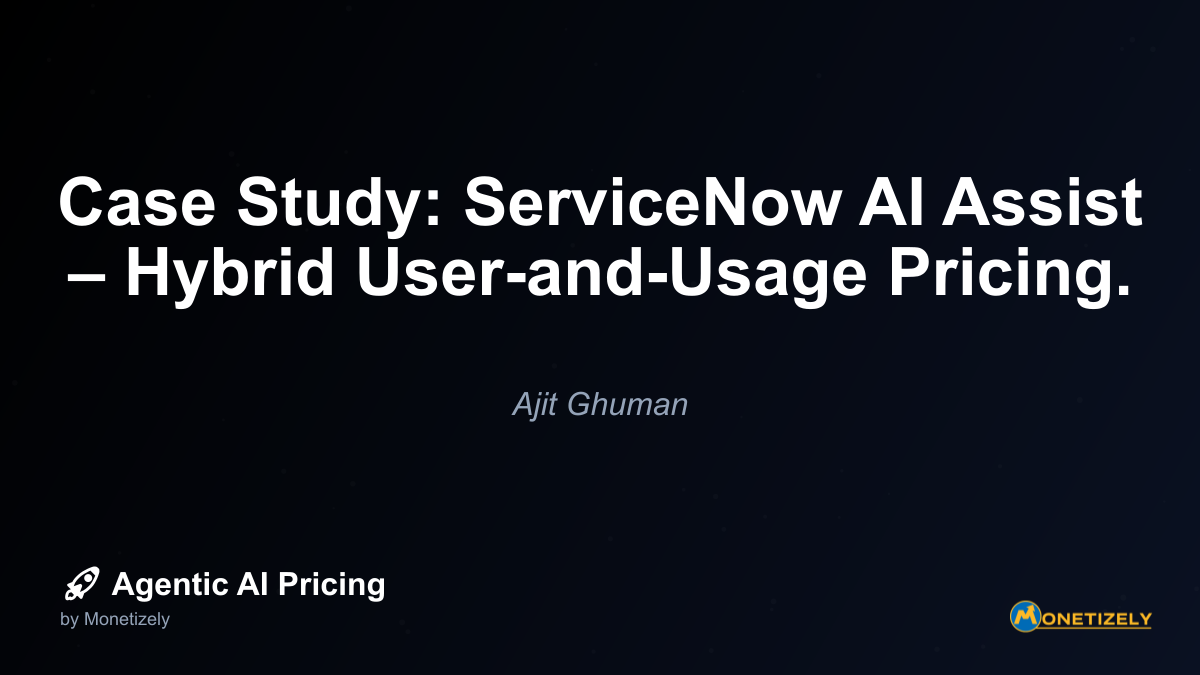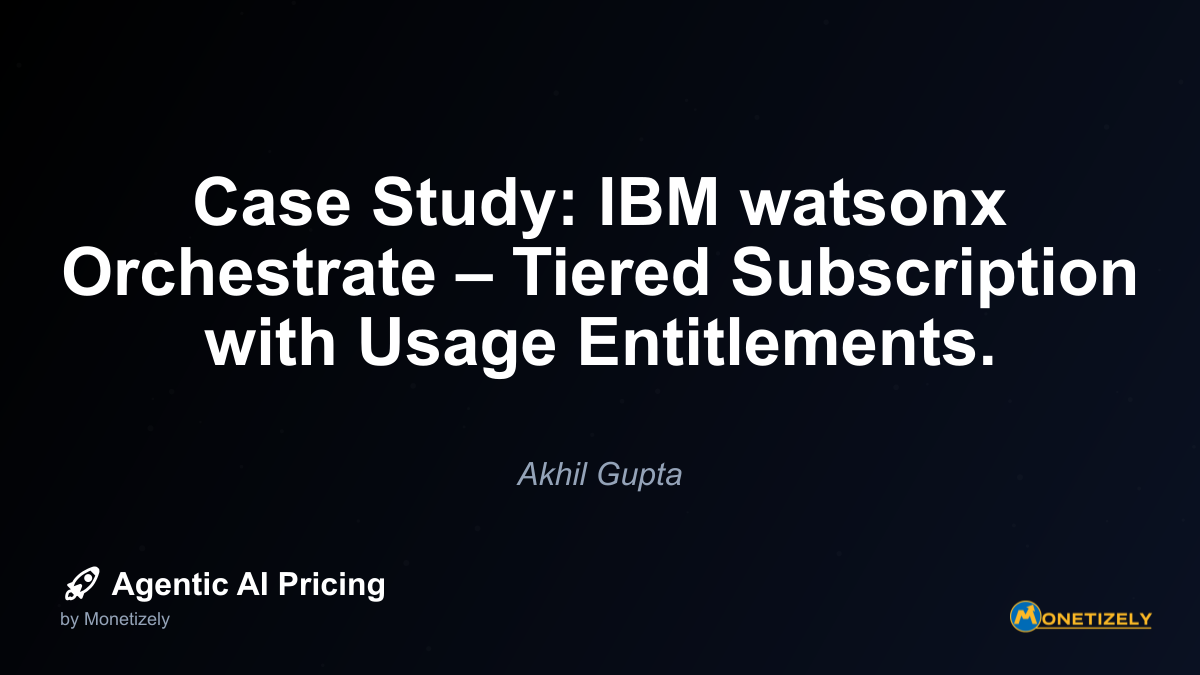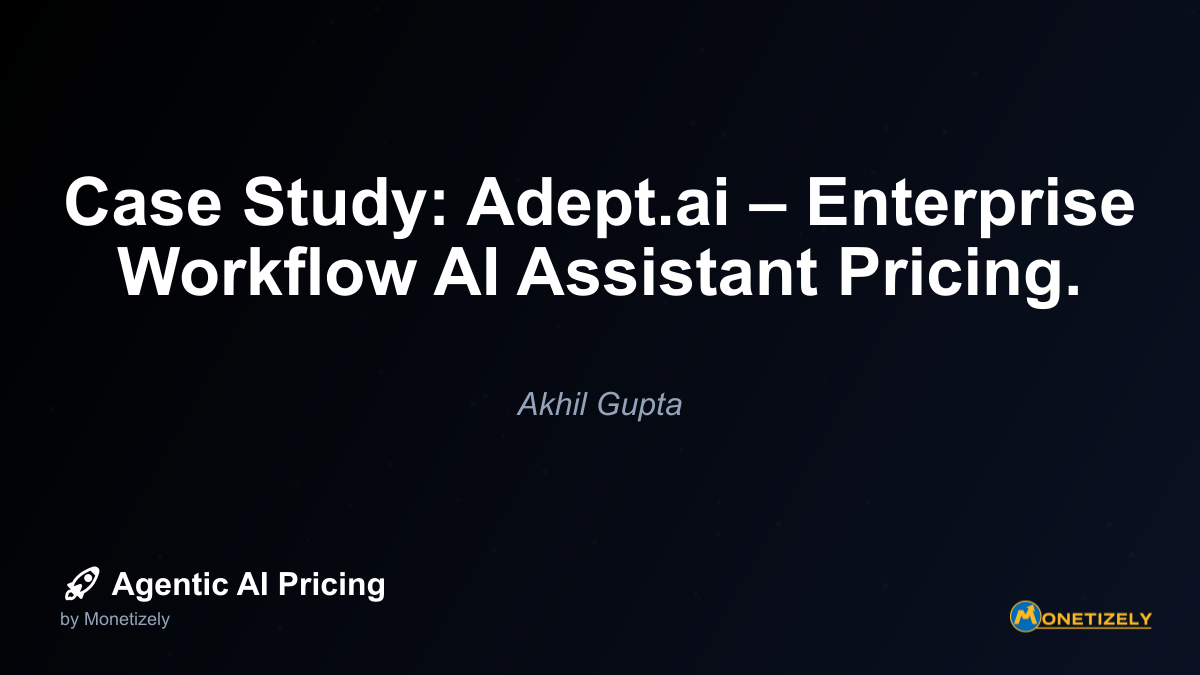· Ajit Ghuman · Case Studies · 5 min read
Case Study: ServiceNow AI Assist – Hybrid User-and-Usage Pricing.
AI and SaaS Pricing Masterclass
Learn the art of strategic pricing directly from industry experts. Our comprehensive course provides frameworks and methodologies for optimizing your pricing strategy in the evolving AI landscape. Earn a professional certification that can be imported directly to your LinkedIn profile.

Market Implications of ServiceNow’s Hybrid Model
ServiceNow’s pricing approach has broader implications for the AI software market as a whole.
Setting Customer Expectations
As one of the major enterprise software players, ServiceNow’s pricing decisions influence customer expectations across the industry. Their hybrid model helps normalize the concept that AI capabilities should be priced differently than traditional software features.
Competitive Positioning
The hybrid approach positions ServiceNow in an interesting competitive space:
- Against pure SaaS competitors, they offer more flexible scaling
- Against pure AI platforms, they provide more predictable baseline costs
- Against consulting services, they offer productized AI with clearer pricing
Market Education
ServiceNow’s approach helps educate the market about the value and cost structures of AI. The hybrid model implicitly communicates that:
- AI has both fixed and variable cost components
- Value scales with both breadth of deployment and depth of usage
- Different user personas have different AI consumption patterns
Implementation Best Practices for Organizations
For organizations considering or implementing ServiceNow’s Now Assist capabilities, several best practices emerge:
1. Start with Pilot Groups
Rather than deploying to all potential users immediately, identify high-value use cases and user groups for initial deployment. This allows for:
- More accurate usage pattern analysis
- Focused value measurement
- Refinement of governance policies
- Better allocation planning for wider rollout
2. Implement Usage Governance
Develop clear policies around AI usage to maximize value while controlling costs:
- Prioritize high-ROI use cases
- Create usage guidelines for different user roles
- Establish approval workflows for certain AI interactions
- Implement monitoring and alerting for unusual usage patterns
3. Regular Optimization Reviews
Schedule quarterly reviews of AI usage patterns to optimize the licensing mix:
- Identify users who consistently exceed or underutilize allocations
- Adjust license tiers based on actual usage
- Consider purchasing additional capacity blocks for high-usage periods
- Document value realization to support renewal decisions
4. Measure and Communicate Value
Develop metrics to track the business value generated through AI usage:
- Time saved through automated resolutions
- Reduction in average handling time
- Improvement in first-contact resolution rates
- User satisfaction with AI-assisted processes
Future Evolution of ServiceNow’s AI Pricing
Looking ahead, we can anticipate several potential evolutions in ServiceNow’s AI pricing approach:
More Granular Usage Tiers
As AI adoption matures, ServiceNow may introduce more specialized usage tiers tailored to specific roles or use cases, allowing for more precise alignment between cost and value.
Value-Based Components
Future iterations might incorporate outcome-based elements, where certain premium AI capabilities are priced based on measurable business outcomes they deliver.
Industry-Specific Packages
ServiceNow may develop industry-vertical AI packages with pricing structures tailored to the unique usage patterns and value metrics of specific sectors like healthcare, financial services, or manufacturing.
AI Marketplace Dynamics
As ServiceNow expands its AI ecosystem, we might see marketplace-style pricing where specialized AI capabilities developed by partners have their own pricing models within the broader Now Assist framework.
Lessons for Organizations Developing AI Pricing Strategies
ServiceNow’s approach offers valuable lessons for any organization developing or refining their own AI pricing strategy:
1. Consider Hybrid Approaches
Rather than viewing subscription and consumption models as mutually exclusive, explore how they can be combined to create pricing structures that align with both customer expectations and value delivery patterns.
2. Match Pricing to Cost Structures
AI solutions often have both fixed and variable cost components. Pricing models that reflect this reality can create more sustainable business models while providing customers with fair value exchange.
3. Provide Transparency and Control
Customers are more likely to adopt AI solutions when they have visibility into usage patterns and controls to manage costs. Investing in robust usage analytics and governance tools can accelerate adoption.
4. Create Natural Growth Paths
Design pricing structures that allow customers to start small and expand as they realize value, removing barriers to initial adoption while capturing more revenue as usage grows.
Conclusion
ServiceNow’s hybrid pricing approach for Now Assist represents a thoughtful solution to the complex challenge of pricing AI capabilities. By combining per-user licensing with usage-based components, they’ve created a model that balances predictability with flexibility while aligning costs with value realization patterns.
As AI becomes increasingly embedded in enterprise software, we can expect to see more vendors adopt similar hybrid approaches, tailored to their specific use cases and customer needs. The most successful models will be those that create win-win scenarios: allowing customers to start small, scale with success, and maintain cost control while enabling vendors to capture fair value for the transformative capabilities they deliver.
For organizations considering AI investments, ServiceNow’s model demonstrates the importance of looking beyond the headline price to understand the complete pricing structure and how it aligns with expected usage patterns and value realization timelines. By taking a strategic approach to AI procurement and implementing proper governance, organizations can maximize the return on their AI investments while maintaining predictable costs.
The evolution of AI pricing models remains a dynamic space, and ServiceNow’s approach represents just one point in the broader spectrum of possibilities. As AI capabilities continue to advance and market expectations mature, we can expect further innovation in how these powerful technologies are monetized.
For more insights on navigating the complex landscape of AI pricing models, check out our article on Subscription vs. Usage-Based AI Pricing and The Founder’s Guide to AI Pricing Models.
Co-Founder & CEO
Ajit is the author of Price To Scale, a top book on SaaS Pricing and is the Founder of Monetizely. Ajit has led and worked in pricing and product marketing at firms like Twilio, Narvar and Medallia. His work has been featured in Forbes and VentureBeat. Ajit regularly consults with software companies from Seed stage to post-IPO on pricing strategy. Ajit is also a highly-rated co-instructor for 'The Art of SaaS Pricing and Monetization' on Maven.
Pricing Strategy Audit
Let our experts analyze your current pricing strategy and identify opportunities for improvement. Our data-driven assessment will help you unlock untapped revenue potential and optimize your AI pricing approach.




